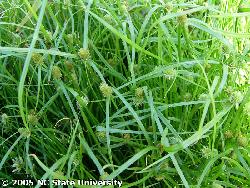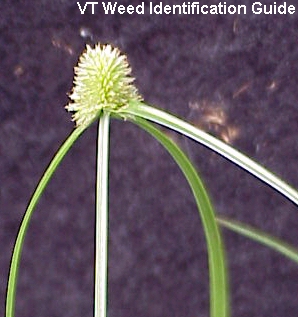Green Kyllinga — Another New Lawn Weed
By Gil Medeiros, former Fairfax Master Gardener
In 1978 I started maintaining my lawn here in Fairfax County. Controlling weeds in the lawn was relatively simple back then. Wild violets, ground ivy, clover, an occasional plantain, and a lonely dandelion were about all I ever saw. I didn’t have much sun back then, so crabgrass was never a problem. I still have these weeds, by the way. I can control them but never get rid of them.
Then in the 1980s (before Google facilitated plant identification for the masses) a parade of new weeds began its march through my yard. First came Japanese stiltgrass, which I controlled by trial and error with chemicals that are no longer available. Then came something that took a long time for me to identify; its name is green kyllinga. Then came yellow nutsedge followed by nimblewill, and most recently Indian mock strawberry. All of these require perseverance on the part of the gardener to control.
Origin

Green kyllinga
I first noticed green kyllinga in my vegetable garden beds in the late 1980s. I suspect it came in with tomato or pepper transplants from local garden stands before I began to start my own seedlings. I have hand-pulled these weeds from the vegetable garden beds for years. Kyllinga was more annoyance than nuisance until about three years ago, when I started to see it in the front lawn near the street. Clearly, this spread from nearby lawns along the edge of the street (notorious weed beds), not from my garden. Nevertheless, I now have to deal with it in the lawn. So far I have been able to keep it from spreading but not eliminate it.
Two years ago, while vacationing in Bethany Beach, I found entire lawns composed of green kyllinga. Not terrible-looking when it is tightly mowed in summer, but not very attractive from the first frost until June the following year. Good thing no one goes there in winter.
Identification

Green kyllinga flower tuft
The flowers have a distinctive appearance. The little flower tuft is about ¼ inch in diameter. The tuft is composed of about 50 tiny flowers, each of which can produce a seed. The flower tuft is surrounded by three long, narrow leaves that radiate from beneath the flower tuft. The symmetry of these leaves makes kyllinga so easy to identify.
Control
The toughest lawn weeds to control have three characteristics in common:
- They are perennials. This generally dictates a control strategy of mechanical removal or application of a post-emergent herbicide. The correct post-emergent herbicide must be selected in order to reduce the damage to the turfgrass. Green kyllinga is a perennial.
- They have an extensive system of rhizomes under the ground. This usually complicates mechanical control. If you do not get all of the rhizomes, the plant will grow back. Also, it generally means that multiple treatments with post-emergent herbicides will be required to kill all the rhizomes. Green kyllinga has rhizomes.
- They are prolific seed producers. Wind, water, foot traffic and small animals are accessories to the petty crime of spreading the seeds. This dictates a strategy of carefully timed pre-emergent herbicide treatment in addition to the mechanical or post-emergent control efforts. Green kyllinga produces an abundance of seeds.
Like other nuisance sedges, green kyllinga prefers moist soil and thrives in lawns that are overwatered.
Aside from some general control recommendations regarding sedges, the 2016 Virginia Pest Management Guide does not address green kyllinga. So we consulted Virginia Tech weed expert Dr. Shawn Askew. The chemicals he cites below are readily available from online vendors. Some may be a bit expensive for the average homeowner, who may choose to contact a professional lawn service.
“This fall, apply Celero Herbicide (imazosulfuron) at 0.33 oz per gallon of water per 1000 sq ft, Dismiss Turf (sulfentrazone) at 8 oz/acre or Sedgehammer (halosufuron-methyl) at 1.3 oz/acre. Seed the area 4 weeks later. The kyllinga will require additional treatments next year. Start when the kyllinga sprouts are first visible (June) and reapply at 4 to 6 week intervals. If you use Dismiss, no surfactant is needed. If you use Celero or Sedgehammer, add nonionic surfactant at 0.25% of the spray solution volume or 1/3 oz per gallon.
“A nonchemical option would include cutting out the kyllinga sod and replacing with tall fescue. Follow-up hand weeding will be needed. Unfortunately, the seed will germinate and establish new patches. Sod replacement also helps to reduce the amount of chemical needed if using herbicides.
“Definitely reduce watering. Only water if turf wilt symptoms start to appear. Consider zone irrigation. Some areas of the lawn may get just what is needed at a frequency of once or twice per week while others may get way too much. On good soil, Virginia lawns would typically only ‘need’ irrigation about 4 or 5 times per year. Each situation is different but reducing irrigation will favor the fescue over the kyllinga.
“Adding dimethenamid (Tower Herbicide) at 21 oz/acre to the preemergence program would help manage new seedling emergence.”
My preference so far is digging out the clumps and replacing them with sod or seed. If you are inclined to use glyphosate (Roundup), not mentioned by Dr. Askew, it works, and of course it kills the surrounding grass. Be ready to treat more than once.
References
Green Kyllinga, University of California Agriculture and Natural Resources
Green Kyllinga, University of Maryland Home and Garden Information Center
Identifying and Understanding False-Green Kyllinga in Cool-Season Turf, Rutgers New Jersey Agricultural Experiment Station